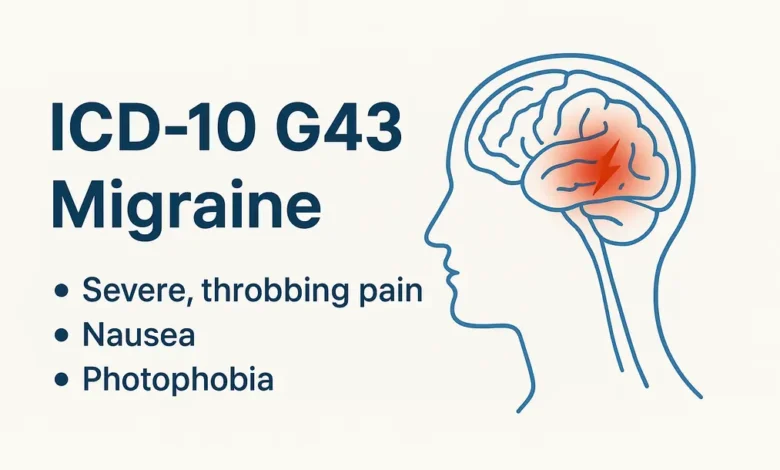Understanding CID10G43: The Complete Guide to Migraine Classification, Meaning, and Management

Introduction: What Exactly is CID10G43?
If you’ve ever come across the code CID10G43, you might have wondered what it means and why it’s used in medical contexts. In simple terms, CID10G43 is a code used in the International Classification of Diseases, 10th Revision (ICD-10), to identify migraine disorders. This coding system, created by the World Health Organization (WHO), helps doctors, hospitals, and insurance companies record and classify diseases in a standardized way across the globe.
CID10G43 specifically refers to migraine, which is a neurological condition characterized by recurrent, intense headaches that can last from hours to days. But beyond the surface, this code carries a lot of important information. It helps medical professionals document the type, cause, and impact of migraines, ensuring that patients receive proper diagnosis and care.
In this article, we’ll break down what CID10G43 stands for, what types of migraines fall under it, how it’s used in healthcare, and what you should know if you’ve been diagnosed with a condition related to this code.
Decoding CID10G43: What the Code Really Means
To understand CID10G43, we need to look at how ICD-10 codes work. The “CID” stands for “Classificação Internacional de Doenças”, which is the Portuguese version of “International Classification of Diseases.” The “G43” refers to the specific section within the neurological disorders category dedicated to migraines.
Each variation of G43 represents a different subtype of migraine. For instance:
- G43.0 – Migraine without aura (common migraine)
- G43.1 – Migraine with aura (classic migraine)
- G43.2 – Status migrainosus (a severe and prolonged migraine attack)
- G43.3 – Complicated migraine
- G43.8 – Other specified migraine
- G43.9 – Migraine, unspecified
This classification isn’t just for medical records—it’s also crucial for statistical research, treatment planning, and insurance documentation. It allows healthcare systems to monitor how often migraines occur, understand patterns in populations, and improve public health responses.
In everyday medical practice, when a doctor writes CID10G43 in your medical report, it’s a formal acknowledgment that your condition falls under the neurological category of migraine disorders.
Why CID10G43 Matters in Modern Healthcare
You might wonder—why do these codes even matter? The answer lies in how healthcare systems operate today. Every diagnosis, from a minor cold to a chronic illness, needs to be properly documented. CID10G43 helps streamline that process when it comes to migraines.
1. Consistency Across the World
One of the biggest advantages of CID10G43 is its universality. Whether you’re visiting a clinic in Brazil, Pakistan, or the United States, medical professionals will recognize the same code for migraine. This ensures that your medical records are understood globally, even if you switch hospitals or move countries.
2. Efficient Insurance and Billing
For insurance companies, the CID10G43 code simplifies claim approvals and reimbursements. Instead of a vague description like “headache,” CID10G43 gives a clear medical classification that justifies specific treatments, medications, or scans.
3. Improved Research and Data Collection
From a scientific standpoint, CID10G43 helps researchers track the prevalence and patterns of migraine across different regions and demographics. This data contributes to advancements in neurological research, leading to new medications and better understanding of migraine triggers.
In short, CID10G43 isn’t just a random code—it’s the backbone of how the medical community identifies, studies, and treats migraines effectively.
Understanding Migraine (CID10G43) Beyond the Code
While CID10G43 gives migraines a structured label, the real experience of migraine goes much deeper. Migraines are not just headaches—they’re a complex neurological event that can affect vision, balance, mood, and even cognitive function.
1. The Stages of Migraine
A migraine typically unfolds in four stages:
- Prodrome: Subtle changes hours or days before the headache, like fatigue or food cravings.
- Aura: Visual disturbances such as flashing lights, blind spots, or zigzag patterns (in some types).
- Attack: The actual headache phase, often severe, pulsating, and localized to one side of the head.
- Postdrome: The “migraine hangover,” marked by confusion or exhaustion after the pain fades.
Not everyone experiences all four stages, but understanding them helps patients and doctors better manage triggers and symptoms.
2. Common Triggers
Triggers can vary widely, but some of the most common include stress, lack of sleep, dehydration, bright lights, loud noises, certain foods, and hormonal changes. Keeping a migraine diary helps people with CID10G43-type migraines identify and avoid these triggers.
3. Symptoms to Watch For
Aside from the headache itself, symptoms can include nausea, vomiting, sensitivity to light and sound, dizziness, or blurred vision. These can severely impact daily life, making timely diagnosis and treatment crucial.
Diagnosis and Treatment Under CID10G43
1. How Diagnosis Works
When diagnosing a migraine under CID10G43, doctors rely on clinical evaluation and the patient’s symptom history rather than laboratory tests. They may ask questions about the duration, intensity, frequency, and triggers of your headaches. Imaging tests like MRI or CT scans are only used to rule out other conditions.
2. Treatment Options
Treatment for CID10G43-related migraines generally includes:
- Medication: Such as triptans, pain relievers, and preventive drugs (like beta-blockers or anticonvulsants).
- Lifestyle Changes: Regular sleep patterns, hydration, and avoiding trigger foods.
- Alternative Therapies: Acupuncture, biofeedback, and relaxation training can also help reduce frequency and severity.
3. Preventive Care
For chronic migraine sufferers, doctors may suggest long-term preventive strategies. This might include Botox injections, CGRP inhibitors, or even neuromodulation devices that help calm overactive pain pathways in the brain.
The key takeaway? While the CID10G43 code helps classify your condition, the real work happens through a personalized treatment plan that fits your lifestyle and symptoms.
Living with a CID10G43 Diagnosis
Being diagnosed under CID10G43 can be both a relief and a challenge. It’s a relief to finally know what’s behind your headaches—but managing migraines often requires patience and consistency.
1. Embrace Routine
Migraines thrive on inconsistency. Keeping a structured routine, from regular meal times to steady sleep schedules, can dramatically reduce flare-ups.
2. Know Your Triggers
Avoiding known triggers—whether it’s skipping caffeine, staying hydrated, or managing stress—plays a huge role in long-term migraine control.
3. Mental and Emotional Health
Migraines can take a toll not just physically, but mentally. Many patients with CID10G43-related conditions experience anxiety or depression due to the unpredictability of attacks. Therapy, mindfulness, and supportive communities can make a real difference.
4. Stay Informed
Medical science around migraines is evolving rapidly. New drugs, wearable devices, and AI-assisted diagnostics are emerging every year. Staying updated helps you make informed choices about your care.
Final Thoughts: Why CID10G43 Isn’t Just a Code
At first glance, CID10G43 might look like just another line on a medical report. But in reality, it represents a vast, ongoing global effort to understand and manage migraines in a structured, scientific way. This code connects patients, doctors, researchers, and health systems under one language of diagnosis and treatment.
For patients, knowing that their condition falls under CID10G43 can bring clarity—and with that clarity comes better treatment options, community support, and a pathway to a healthier, more balanced life.
So the next time you see CID10G43 in your records, remember—it’s not just a number. It’s a key to understanding your health, empowering your decisions, and taking control of your migraine journey.




